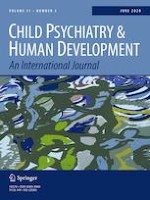01-01-2020 | Original Article
Callous–Unemotional Traits and Disorganized Attachment: Links with Disruptive Behaviors in Toddlers
Gepubliceerd in: Child Psychiatry & Human Development | Uitgave 3/2020
Log in om toegang te krijgenAbstract
Children with callous–unemotional (CU) traits and children with disorganized attachment patterns are at heightened risk of poor psychological outcomes but little is known about the overlap between these constructs and their unique contributions to conduct problems in early childhood. This study examined associations between CU traits, disorganized attachment, and conduct problem (CP) severity in a sample of clinic-referred toddlers with behavioral problems. Mother–child dyads (n = 56; mean child age 19.50 months) completed parent-report questionnaires, a dyadic play session, and the Strange Situation Procedure to assess child attachment pattern. Significant positive associations were found between CU traits and disorganized attachment, independent of CP severity. CU traits but not disorganized attachment predicted CP severity. Results indicate that among toddlers with clinic-referred disruptive behavior problems, there are clear links between CU traits and attachment disorganization. Of the two constructs, however, CU traits appear to be most salient in the expression of CPs.
